Kids. For every hard-working junior scholar in the world, there’s probably four or five little hooligans who prefer to walk on the wild side. You know, the kids who race their Big Wheels down steep hills, poke bee hives, throw rocks at dogs or joy-ride their mom’s car at 15.
The OEMs are grateful for these kinds of kids, as they are the prime demographic for the quartet of outrageously fast and capable machines assembled here.
Does anyone need a bike with an insane power-to-weight ratio that exceeds million-dollar cars? No! But is there a large group of adult-aged kids with a ravenous appetite for adrenaline? Hell, yeah!

And so we have a group of bikes in which the weakest of the bunch pumps out 154 horsepower at the rear wheel, all neatly packaged inside wheelbases tighter than 55.7 inches. They are essentially production racebikes, including only a smattering of street equipment to make them road legal.
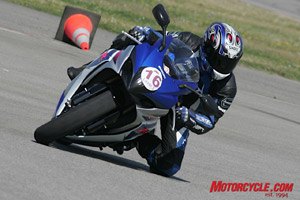 The GSX-R1000 is a dominating presence in racing for a reason. The highly-refined package of a superb chassis and an engine with meaty torque and a potent top-end is a powerful combo. |
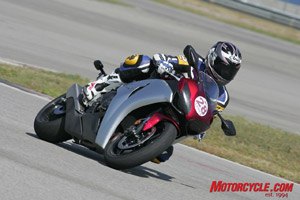 |
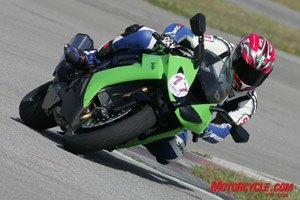 |
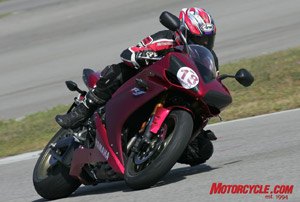 Though maybe not a favorite on the street, the venerable R1 is a serious force on the track. The R1 engine screams at the top of its rev range, has good brakes and excellent handling. |
Headlining this group is the mighty Suzuki GSX-R1000, a perennial leader in the literbike category. It’s won more shootouts than Billy the Kid, and its Superbike cousins have taken victories in each of the past 32 races of the AMA Superbike series. It was heavily revised for 2007, adding some top-end power along with some extra pounds, and it came up just short of winning Motorcycle.com’s 2007 Literbike Shootout.
The Gixxer remains a potent package. Its hell-strong motor battles for top honors with a combination of strong bottom-end thrust and shrieking power up top. Its race-bred chassis is almost beyond reproach, boasting a near-perfect amalgam of agility and stability. And if you’re the type of owner who can’t leave well enough alone, the GSX-R has the most plentiful aftermarket support, whether your playground is a racetrack or the fat-tire world of burger joints and bike shows.
Last year’s winner came from the Honda camp, as our testers judged it to be the most complete package that made it the best option for street riders while being manageable and cooperative on the racetrack. That’s nice, but Honda threw away that model and replaced it with a ground-up re-do in 2008. Introduced at the glorious Laguna Seca circuit, the overhauled CBR thrilled us with its newfound power and its lightweight and responsive new chassis. It was obvious back then that the new Honda would again be contending for top honors.
This new CBR performed well no matter which venue we threw it in. On the street, we enjoyed its punchy powerband and reasonably comfortable ergos. But don’t get the idea this is some sort of CBR-F model, as its RR lineage shone brightly during our day lapping the newly renamed California Speedway, now Auto Club Speedway, as its compact stature and sharp steering geometry allowed it to be briskly hustled through the track’s dozens of turns and chicanes.
Kawasaki had a bigger hill to climb in ’08. Last year in our comparo the ZX-10R finished fourth of four, despite its monster motor that never failed to make our eyes water like a tween at a Jonas Brothers concert. It had bulked up with its 2006 revision, both in weight and in size, causing it to win few converts in this elite class. Lucky for us (and Kawi), they threw out the baby with the bathwater and gave birth to a new sports bike in ’08.
This new 10R is more compact than before and feels more taut, but still with knockout punch from its thoroughly revised mill. It’s also notable for its KIMS (Kawasaki Ignition Management System) traction-enhancing (don’t call it traction control!) software, which we first sampled during the bike’s introduction at the Losail circuit in Qatar late last year. The most obvious change is the Ninja’s sharp-edged styling that polarizes opinions.
Yamaha returns to the ring with its sexy YZF-R1 virtually unchanged from ’07. The notable difference is a new computer brain that eliminates the ghosts-in-the-machine stumble in second gear at 5500 rpm of last year’s U.S.-spec bike, which was a no-cost retrofit to affected early-production ’07s. The R1 is otherwise unchanged except for color options, like the new gloss/matte two-tone Candy Red combo.
Although unchanged mechanically, the R1 has some high-tech gadgetry the others don’t, such as the throttle-by-wire and variable-length intake trumpets it gained last year. A slipper clutch was also added to the YZF’s standard equipment list in ’07. The R1 has always been a looker, and it’s still a favorite among some of our testers, but even Claudia Schiffer levels of style get a little stale eventually. The Yamaha’s undertail exhaust, formerly one of the bike world’s must-have features, now stands alone in the contemporary literbike class (with the exception of the Ducati 1098).
Last year’s test was subtitled “A Thin Line,” as the capabilities of the four Japanese literbikes had grown so vast that there weren’t many notable differences between them. Despite two revamped contenders, it’s a similar story in 2008. If this were a poker tournament, the OEMs would be “All In.”
To give the bikes as comprehensive evaluation as possible, our Motorcycle.com trio of staffers was aided by three test riders. Steve “Speed” Kelly took part in last year’s comparo, so he was an obvious choice. Jeff Buchanan recently took us inside Jay Leno’s garage and wrote our profile on debutante bike builder Roland Sands, and while we were paying his invoice we roped him into joining us at the racetrack and for a pair of street rides. A new recruit to MO is Alexandra Bongart, a sportbikin’ lady who rides her own Gixxer 600. She handily upped the attractiveness scale of our test monkeys.
For maximum objectivity, we decided to score this shootout by the cumulative sum of scores over 12 categories that encompass the things we care about in a motorcycle. Note that half the name “motorcycle” refers to an engine, so you can understand why we score it out of 20 points compared to the maximum of 10 in the other categories.
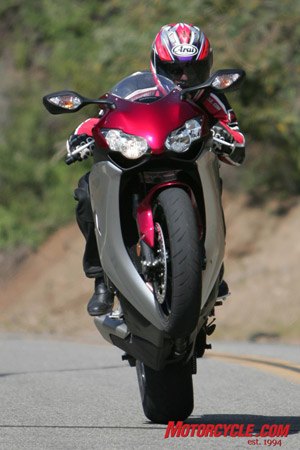 With incredible mid-range stonk, the CBR can do this almost at will. |
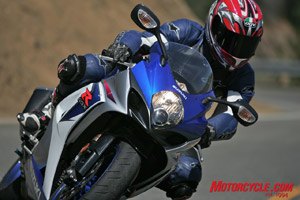 Our good buddy Jeff Buchanan thought the Gixxer is just as amenable to everyday street use as it is a brilliantly honed track weapon. |
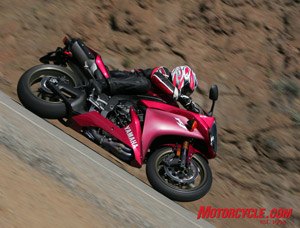 The R1 has many outstanding qualities, but its relative lack of low-end power was seen as a negative for everyday street use. And that, whether we like to admit it or not, is where most of these bikes will see the majority of their miles. |
Engine
(power, tractability, response, user-friendliness, vibration)
1. CBR1000RR – 98%
2. ZX-10R – 92%
3. GSX-R – 90%
4. YZF-R1 – 78%
Yep, the Honda’s new mill is a gem, specifically its hard-hitting midrange power that a rider can use during each run through the gears. The others put up bigger numbers on the top end, but those extra 4 horsepower (or less) can rarely be accessed. The CBR’s middle-rev grunt is vastly superior to the others in this test, and the CBR handily dusts its contemporaries in any roll-on contests. It’s the only bike in this group to unintentionally wheelie when exiting Auto Club Speedways Turn 6, demonstrating its torque superiority. Its 78.2 lb-ft is not only the highest, more importantly, it also has a huge advantage from 5500 to 8000 rpm and remains the torquiest all the way to 10,000 revs. “This simply makes it the best mill for the street,” says Senior Editor Pete Brissette.
That said, the CBR’s engine isn’t quite perfect. Its low-end response is soft, perhaps due to its exhaust flapper valve that doesn’t open until 4500 revs and is audible when it does. Slow-speed maneuvering such as when lane-splitting can fool with the Ignition Interrupt Control system, which otherwise does a fine job at smoothing throttle transitions in its parameter below 6000 revs. The Idle Air Control Valve in its fuel-injection system eases transitions when opening and closing the throttle, helping make this heady engine astonishingly undemanding.
The ZX-10R continues the long tradition Kawasaki has earned for monster motors. On the dyno, the Ninja spat out 157.74 hp (to SAE standards), just edging the formidable Gixxer for the top producer in this quartet. Conversely, the ZX has the lowest torque output, although 73.9 ft-lbs is nothing to sneeze at. On the high banks of ACS, the ZX’s speedometer showed a max of 181 mph, which was higher than the others. “The ZX-10 has a great motor,” says Buchanan. “It really feels like it pulls with great punch right off of idle, despite the dyno begging to differ.” One extra tooth on a new rear sprocket aids torque multiplication, especially at street speeds.
The Kawi engine has a split personality. It’s rough and vibey below 4000 rpm and doesn’t have much grunt. Then it magically smoothes out and, by 5000 revs, it’s ready for blast off. Vibes are worst below 3000 rpm, buzzing the fairing and ignition key coarsely. Throttle transitions are exceptionally smooth. It’s difficult to say how well the KIMS works; by the end of our trackday the ZX’s rear Bridgestone BT-016 was regularly drifting under acceleration, though it was doing so in a controllable manner. KIMS is obviously not true traction control, but it does seem to make this rorty powerband easier to manage.
The GSX-R’s powerplant is in some ways superior to the Ninja’s, posting nearly equal peak power (157.65 ponies) while offering best-in-group thrust below 5000 rpm, in part due to the most undersquare bore/stroke ratio. “Its easy access to its torque makes this a sensible streetbike for as sensible as a modern literbike can be,” says Brissette. Indeed, Suzuki’s Dual Throttle Valve fuel injection offers near seamless response along with its wailing top end. Suzuki’s Drive Mode Selector, offering three levels of power output via a bar-mounted switch, was deemed gimmicky by our testers and was rarely sampled. Might be good in the rain...

Speed Kelly, who last year ranked the Gixxer tops when he rode it on the street, became a convert to Team Green after romping around ACS. In that environment, he judged the GSX-R’s engine as being a few points down from the tractable ZX and its banshee surge to its power peak. Still, the Gixxer motor is a formidable mill and operates without any glitches, but the Honda rules all from 5000 to 10,000 rpm, right where it counts.

Anyone who has ridden the compelling Yamaha YZF-R1 knows its considerable charms, and if they haven’t ridden these other literbikes back to back, they’ll certainly take issue with our score for the R1’s engine. But jumping from one bike to another reveals the Yamaha’s relative dearth of midrange power. You’ll have to take our word for it, a feeling that is reinforced empirically via our dyno runs made at Area P, a SoCal exhaust manufacturer and fabrication shop.
Simply put, there’s not really anywhere in the R1’s powerband that it outclasses any of its rivals, and it’s especially soggy around 7000 rpm despite variable-length intake snorkels that should do a better job at boosting midrange power before opening at 10,400 rpm. “Midrange revs are not where the Yamaha wants to be,” notes Speed Kelly about the engine with the most oversquare bore/stroke. “Although it has awesome power and drive, the fueling lower down the rev range is finicky and really spoiled what is a great bike.” A few of the crew also commented on the R1’s occasional abrupt response when reapplying throttle. This motor is still a ripper, but it’s now the tail-ender in this esteemed group.

Transmission/Clutch
(clutch actuation/modulation, shift ease, precision, slipper clutch)
1. CBR1000RR – 94%
1. ZX-10R – 94%
3. GSX-R1000 – 90%
4. YZF-R1 – 84%
The CBR completes its lofty powertrain marks with the easiest-to-modulate clutch and a snick-snick transmission that makes dialing through the gears a breeze. They’re augmented by Honda’s Ignition Interrupt Control technology that eases drivetrain lash. “The tranny is so slick that, even though I know I moved the lever, I could barely feel each shift,” Brissette gushes. Honda’s first mass-market slipper clutch is nearly as smooth as the class-leading ZX.
In this category, the Kawasaki traded top marks with the CBR among our cadre of testers. This is the best gearbox yet offered on a ZX-10R, with light, precise shifts and the best back-torque-limiting clutch in the biz. The Suzuki received no specific complaints from our crew, but it received no special kudos, either. Bringing up the rear is the Yamaha. Its clutch engages only at the end of its travel, it’s hampered by a tall first gear, and its slipper clutch engages more harshly that the others here.
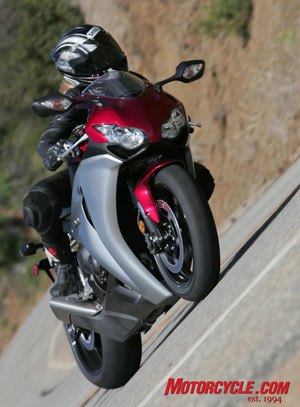
Again, Alex appreciated the more-compact ergos of the CBR, likening it to the Gixxer's fit. Guess it's a good thing we brought along a sensible woman.
Handling
(quickness, feedback, stability, confidence)
1. CBR1000RR – 96%
2. YZF-R1 – 90%
2. GSX-R1000 – 90%
4. ZX-10R – 88%
The CBR wowed us again in this important category, boasting the seemingly incongruous qualities of agility and stability. With the steepest rake (23.3 degrees), the least trail (96mm) and the shortest wheelbase (55.4 inches), it’s no surprise that the CBR dices up corners most like a 600. But such geometry can be a recipe for a head-shaking beast. The RR gets away with it thanks to its electronic steering stabilizer that increases damping force in relation to velocity, gear selection and throttle position. It provides stability at butt-puckering speeds while allowing for swift direction changes at more modest rates of travel. It only becomes slightly detrimental at high speeds, such as AC Speedway’s Turn 1 chicane at about 125 mph, where its restricted damping makes steering more laborious. Honda continues its intense quest for mass centralization, eschewing the old underseat muffler for one that exits under the engine. The CBR’s ace in the hole is a fueled-up weight about 25 pounds less than its competitors (and 17 lbs fewer than last year).
“Straight away, the CBR instills you with confidence, allowing you to just get on with riding as quick as your ability will allow,” raved Brit-boy Kelly.
The R1 and GSX-R got to their identical scores in slightly different ways. The GSX-R geometry is only incrementally looser than the CBR’s in all three measurements, so the Suzi also does a good job at unraveling twisty roads. “Direction changes are fast and clean,” says Buchanan, “with the bike tackling corner entrances and turns with a kind of hyper finesse.” Its steering damper also adjusts electronically but it’s not as sophisticated as the excellent Honda unit. Regardless, the Suzuki’s handling is very composed. “It has good front-end feedback,” Pete suggests. “It holds a line very well, and the chassis isn’t ever upset by hack riding or mid-corner sloppiness.”
Despite its long feeling and moderate steering geometry, the R1 is endowed with quick steering qualities thanks to a wide, flat handlebar position. But its best attribute is its secure feeling when banked into a turn, allied by a steering damper that gets clamped down hard only during headshake scenarios. “The Yamaha has a beautiful temperament when it comes to handling,” comments Buchanan. “It’s like a Ducati, with very graceful manners – stable and smooth.”
The ZX-10R tailed the pack only slightly. Kawi’s new chassis has gone the opposite direction from Honda, now with a surprisingly lazy 25.5-degree rake and a generous 110mm of trail; its 55.7-inch wheelbase is identical to the Gixxer and R1. This would indicate sluggish handling, but that’s not the case. “Corner entry is excellent, and mid-corner it was super stable,” enthuses Kelly, our strongest proponent of the Ninja. Revised chassis rigidity results in confident transitions, and I was particularly impressed with the feedback from the ZX’s front end on the track. Others, like Pete, weren’t as confident with the Ninja, although he did allow that it is dramatically better than the previous model. The green meanie proved to be a bit finicky to set up. Headshake while accelerating over Turn 10 at ACS was dialed out by ace wrench Joey Lombardo via the addition of a 6mm shim to the rear shock and adjusting damper settings; the shim was removed to revert to the stock ride height for our street testing, and we wonder if the ZX would’ve scored higher if we left it in. The Ohlins steering damper uses Kawi-specific settings, which are softer than a typical race damper.
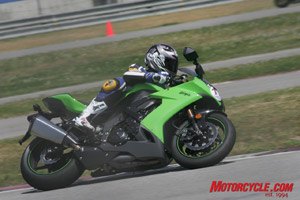 Steve "Speed" Kelly was in love with the new Ninja. Who can blame him? |
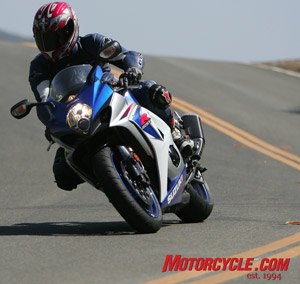 Next to the stretched out R1, the Gixxer suited the 6-foot Buchanan the best. Adjustable footpegs is a desirable feature only the Suzuki has. |
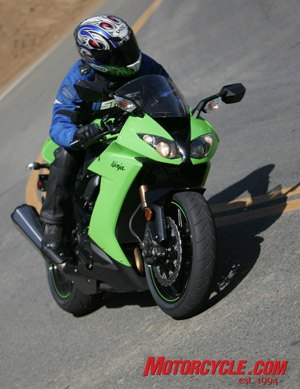 Though the Ninja's performance is unquestionable, Pete wasn't too keen on the new, origami-inspired styling. |
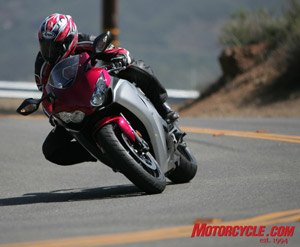 As Pete says, Honda not only make CBRs to win at the track, they also make them very livable on the street. |
Brakes
(power, modulation, initial bite, feedback)
1. ZX-10R – 98%
2. CBR1000RR – 94%
3. YZF-R1 – 92%
4. GSX-R1000 – 82%
All bikes in this echelon offer eyeball-popping deceleration via triple-disc brakes, radial-pump master cylinders and radially mounted multi-piston calipers, but the Kawi’s package received outstanding marks from our testers from its combination of 310mm petal-shaped rotors and differential-bore 4-piston Tokico calipers. Pete summed it up by saying, “Best brakes of the group – most power and best feel.” The Honda’s one-piece Tokico calipers were a close runner-up, losing out only for a slight lack of initial bite.
The R1’s brake package, with a Brembo radial master cylinder and 310mm discs, also was rated highly, but the only 6-piston calipers of the group don’t provide the acuity of feel as the best in class. The Gixxers brakes are no slouch, but in this group they proved to be lacking. Our testers didn’t like pulling through a weak midpoint in lever travel before accessing the bulk of their power.
Instruments/Controls
(legibility, features, attractiveness)
1. ZX-10R – 94%
2. CBR1000RR – 86%
2. GSX-R1000 – 86%
4. YZF-R1 – 84%
Each bike here contains a stylishly compact gauge pack with programmable shift lights, dual tripmeters, clock and an easy-to-read LCD speedometer. After several years of bitching about the 10R’s hard to read gauges, the Kawi engineers finally got this one right. Revs on its analog tach are highly legible, and its handy gear-position indicator is matched only by the Suzuki. The CBR’s gauges provide fuel economy figures but no gear indicator, and its LCD displays numbers too small to be read at a glance. The Gixxer gets docked marks for its plain design and lack of a lap timer. The R1 instruments are among the most attractive, but some of our testers would’ve appreciated a gear indicator.
Ergonomics/Comfort
(overall layout)
1. CBR1000RR – 92%
2. GSX-R1000 – 90%
3. ZX-10R – 84%
3. YZF-R1 – 84%
The scores in this category were all over the map and were dependant on the size of the rider, as was the comfort of the seat pads. Overall, the Honda was judged to be best ergonomic compromise with its small, easy-to-handle size, a 1.2-inch narrower midsection than previous and a relatively comfortable handlebar position and seat height. The Gixxer has a similar ergo package and gets bonus points for having adjustable footpeg positions, but not everyone liked the swept-back position of its clip-ons.
The R1 and ZX lie at opposed ends of the spectrum. Even though the Ninja’s 32.7-inch seat height is the tallest of the bunch, it has a cramped seat-to-peg distance similar to the CBR, so taller riders like the six-foot Buchanan preferred the roomier layout of the R1. “Its cockpit and pegs are laid out in such a way that my knees were least affected. This translated into less pain, more endurance, and therefore, faster laps on the track. For me, few things can replace comfort.”
Although Jeffers appreciated the longer reach to the bars and pegs rear-set further than the others, our shorter testers found it least comfortable. Pick your poison. None of these machines offer much in the way of wind protection, but the Gixxer is the best in this regard. Rearward images through the mirrors are only adequate, with no bike offering a clear advantage.
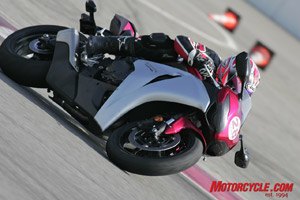
We wish more literbikes would follow Honda's lead in the exhaust department. This design keeps the look clean and lowers the C of G.
Suspension
(control, comfort, ease of adjustments)
1. CBR1000RR – 94%
2. ZX-10R – 92%
2. GSX-R1000 – 92%
4. YZF-R1 – 90%
Modern literbike suspension is so good that there was little to differentiate the bikes from another, and the suspension quality depends so much on their set-ups. The Honda gets the nod here for its benign baseline that feels buttoned down without being harsh. A few clicks out on its compression damping made is relatively supply on the street, and its ramped preload adjuster on the shock makes for quick adjustments. It doesn’t seem to suffer from its lack of separate high- and low-speed compression damping adjustments as seen on some of the others.
The Gixxer and ZX tied in this category. The Ninja’s suspension was deemed to be suppler while being well controlled, but it was more finicky with its setup. The GSX-R, conversely, was very composed no matter the riding environment. Both have DLC coatings on their fork tubes for a minimum of stiction, so they react readily to small bumps. Both also have a locking-ring-type shock preload adjuster that complicate setting the correct amount of sag. Conversely, the R1 has a ramped preload adjuster (like the CBR) that can quickly be fiddled with on the roadside.
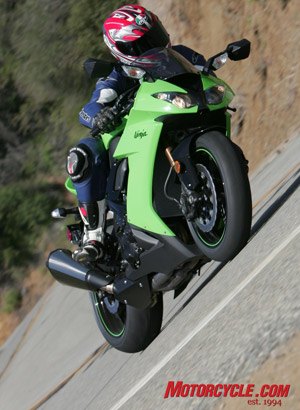
A drawback on the ZX-10R for Jeff, who stands 6 feet, was the tight seat-to-peg relation. Even Pete and Kevin, both shorter than Jeff by at least one fathom, felt the Ninja would be a good candidate for adjustable rearsets.
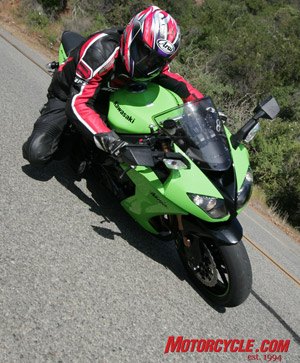 Though it has funky mirrors and signals, it still turns like a champ. |
Fit and Finish
(how well is it put together, etc)
1. CBR1000RR – 98%
2. YZF-R1 – 88%
3. ZX-10R – 82%
3. GSX-R1000 – 82%
Another clear victory for the CBR. Honda has turned out a package that looks more expensive than its rivals. Notable details include the Honda badge inset into the fuel tank cover, the embossed CBR1000RR logo on the fairing’s side panels, and attractive mirrors that incorporate turnsignals and subtle LED running lights. But no matter where you look, the Honda’s detail work is second to none.
Some of our testers believe the R1 is beginning to look a little dated, but there’s no questioning its excellent fit and finish, as is typical of recent Yamahas. Some of the ZX’s details are exemplary, such as its black-anodized foot controls, but others, like the bulky and plastic hugger fender, look cheap. The Gixxer’s detailing is satisfactory, but its finish quality doesn’t match the high standards set by Honda and Yamaha.
Appearance
(self explanatory)
1. CBR1000RR – 90%
2. YZF-R1 – 86%
3. GSX-R1000 – 84%
4. ZX-10R – 80%
Being a purely subjective category, your mileage may vary, but we have a diverse bunch of opinions that result from long looks over the bikes from every possible perspective, so they count for something. The CBR again scored highest, with a compact stature that shows its dim relation to a MotoGP bike. “The Honda is extremely clean and tidy,” Buchanan relates. He adds that he likes the snout of the under-slung exhaust, but not all our testers were on board with his opinion of the controversially styled exhaust. Some of us also weren’t too keen on the CBR’s headlight treatment, preferring the mask-like design of the previous iteration. The maroon/silver two-tone scheme of our RR might not be its most attractive outfit, although Pete dug it.
Second-place marks for the R1 demonstrates the enduring nature of its relatively old design – it still looks sharp. Although its underseat titanium mufflers might be a little passé these days, they look cool (even though cool is the last thing on your mind when they’re cooking your butt in summertime traffic). The Gixxer drew mixed scores, with some lamenting a too-familiar appearance, especially in Suzuki’s traditional blue/white color scheme. Pete wasn’t alone in comments about his distaste for the looks of the dual exhaust canisters. Not that many preferred the Kawi muffler’s kitschy angular megaphone design, nor its oddball turnsignals set into the mirror stalks. Buchanan and others liked its menacing countenance, while others complained about the cross-eyed look of its close-set headlights.
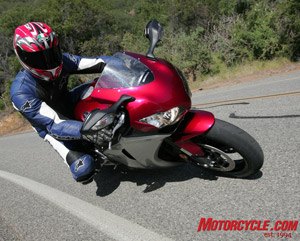 |
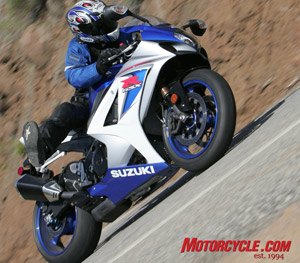 |
Cool Factor
(desirability, poser value, extra features)
1. CBR1000RR – 94%
2. ZX-10R – 88%
3. GSX-R1000 – 86%
4. YZF-R1 – 84%
To our crew’s collective eyes, the CBR1000RR comes off as something special, and it’s a feeling that’s reinforced by riding it. And with more acronyms than the NY stock exchange (HESD, IIC, IACV, etc.), it comes loaded with special features. The distinctive yet funky Ninja and the racy Gixxer fought over second place. The 10R’s KIMS was deemed a more worthy feature than the GSX-R’s S-DMS. The Yamaha is no doubt cool, but it doesn’t offer any special features the others don’t.
Grin Factor
(how big a smile it puts on your face)
1. CBR1000RR – 94%
1. GSX-R1000 – 94%
3. ZX-10R – 90%
4. YZF-R1 – 76%
Another subjective category, but few things are as important as this one. In fact, we wouldn’t blame you for deciding on a bike based solely on this criterion. The Honda stands out for its stonkin’ midrange power and its middleweight-like handling. The Gixxer’s mega motor, its visceral intake snort and composed chassis made us smile. “There's something about the way the GSX-R makes its power that endows it with a rawness that gives the bike character and is fun in that way,” says our boy Petey.
The ZX-10R makes our lips turn up for its pure bad-assedness. Meanwhile, the poor R1 gets backmarker scores because of its relative lack of accessible torque, a tall first gear and an exhaust system that creates rump roast. Our shorter testers weren’t fond of its stretched-out ergos.
Price
1. GSX-R1000 ($11,499) – 100%
2. ZX-10R ($11,549) – 98%
3. CBR1000RR (11,599) – 96%
4. YZF-R1 ($11,699) – 94%
Although there’s less than a 2% difference in MSRPs, we gave top marks to the lowest entry price. The Gixxer ensures its place at the top by including a seat cowl piece as standard equipment while the other OEMs charge extra for it. Kudos to Kawasaki for not charging extra for the clear-coated pinstriping on the wheels of green ZXs that are said to cost the manufacturer an extra 100 clams.
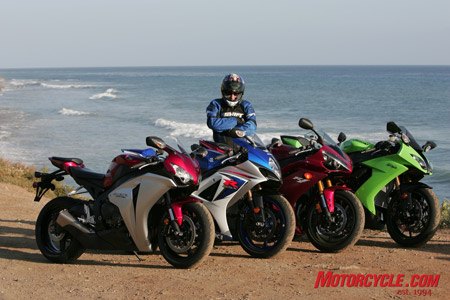
I'm not writin' any of this shootout, see!
The Final Tally
First Place
Honda CBR1000RR - 94.2%
view bike specs
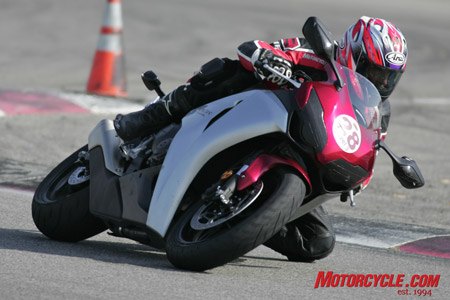
Honda came out swinging for 2008. The CBR1000RR continues the Honda tradition of epitomizing refinement. Simply the most mid-range power of all four makes the bike from Big Red very easy to ride, but a wild beast lies just beneath the surface.
Honda’s new CBR raises the bar in the literbike class. It’s the most responsive, it has the best powerband, it’s the easiest to handle and it’s the coolest of the bunch. “Everything about the Honda is just so perfect – brakes, midrange power, stability,” raved Kelly. “It’s pure genius when a bike can be designed that makes going so fast feel almost mundane.”
Buchanan concurred, saying, “If I had to pick a winner based on all fronts, it would have to be the Honda. It possesses a space-tech type of performance that is outstanding. Definitely the most user-friendly of the bunch in the real world (i.e. back roads, freeway, stop and go, and the occasional trackday). The bike performs in all the categories with unequaled consistency.”
| Highs: | Sighs: | |
|
| |
| The Perfect Bike For... | ||
| A race-rep for those who value a nimble chassis, accessible power and Honda-typical quality. | ||
Second Place
Kawasaki ZX-10R – 90.3%
view bike specs
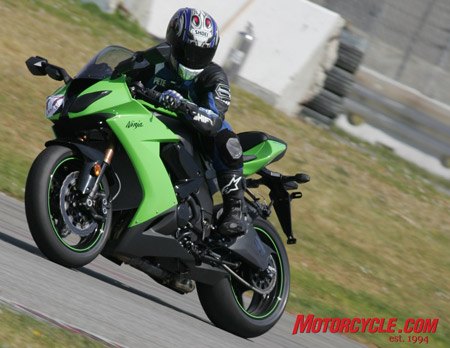
Who dat?
Kawasaki really raised its game with the new 10R, going from back of the pack to contending for victory. It, like the CBR, is amazingly easy to ride for machines that can turn animalistic when unleashed. “Everything about the bike is taut and crisp,” raved Speed Kelly, the Kawi’s biggest fan. “It’s very racer-like in nature yet still user-friendly, almost Honda-like in feel. It went from zero to hero in my book, and if forced to choose an overall winner, it would have to be the bike I most wanted to ride again at the track: the ZX-10.”
The ZX’s problem is that not all our testers warmed to its brutish charms. While Steve fell in love with the Kawi at the track, the ZX also had its detractors who couldn’t warm to its styling or its tight ergos that became bothersome during long street stints.
| Highs: | Sighs: | |
|
| |
| The Perfect Bike For... | ||
| Team Green disciples who have been waiting for one of the best racetrack weapons available thanks to its user-friendliness for such a monster. | ||
Third Place
Suzuki GSX-R1000 – 89.1%
view bike specs
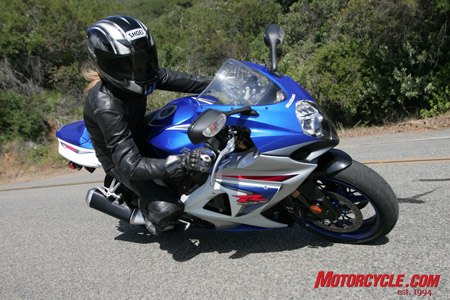
Alex, the only girl brave enough to suffer a group of mutant dudes, echoed Pete's sentiments that the GSX-R is easy to ride thanks in part to its overall trim and smaller feel.
Although Suzuki won’t be happy with a third-place finish, the two-year-old Gixxer posted solid scores that were barely beaten by the fresh-design Ninja. This bike just flat-out works, and if you dig the way it looks, you’ll feel blessed to be in its saddle. “With its narrow waist and overall slim package, the Gixxer feels like a bike half its displacement,” says Brissette. “It’s a literbike that feels like a 600 or 750 when you sit on it.”
The Suzuki’s only bottom-ranked score was for its brakes, which are nonetheless quite good. “I still think the GSX-R makes a superb streetbike/canyon carver and trackday bike,” notes Kelly. “It just seems to lack the response and flickability of its newer cousins.”
| Highs: | Sighs: | |
|
| |
| The Perfect Bike For... | ||
| A racer or customizer who wants to capitalize on the GSX-R’s well-earned rep as a top-dog sportbike. | ||
Fourth Place
Yamaha YZF-R1 – 85.2%
view bike specs
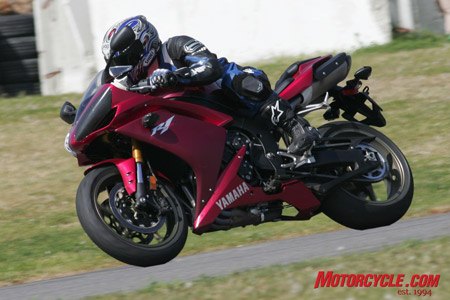
The R1's top-end-biased power is a drawback on the street, but it performs as well as anything on the track.
During one of our last rides on these bikes, I muttered inside my helmet that it’s hard to believe a bike this good could be ranked fourth. Its tall first gear works well on tight canyon roads, it emits a cool burble from the undertail exhaust on the overrun and it transmits good feedback from the front tire. Its only notable shortcoming is its engine’s relative lack of responsiveness and a clutch and transmission that aren’t very street-friendly. “The Yamaha just needs a little more midrange and some fueling issues fixed to be a contender,” Kelly allows.
But there’s still much to like here, including its stable handling and styling that some think is the best in class. "Initiating a turn happens easily and the bike holds a line brilliantly," says Petey. "It was the easiest and most confidence-inspiring to ride on a track that was new to me." Yamaha’s saving grace is that an all-new design is expected for ’09.
| Highs: | Sighs: | |
|
| |
| The Perfect Bike For... | ||
| A rider who falls in love with its looks and doesn’t sample the others in this group. | ||
Related Reading
2008 Kawasaki ZX-10R Preview
2008 Kawasaki ZX-10R Review
2008 Honda CBR1000RR Review
2007 Literbike Shootout
2006 Open Superbike Shootout
2007 Yamaha R1 Review
2008 Suzuki GSX-R600 Review
2008 Yamaha R6 Review



Tidak ada komentar:
Posting Komentar